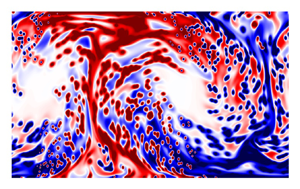No CrossRef data available.
Article contents
Large-scale convective flow sustained by thermally active Lagrangian tracers
Published online by Cambridge University Press: 02 December 2022
Abstract

Non-isothermal particles suspended in a fluid lead to complex interactions – the particles respond to changes in the fluid flow, which in turn is modified by their temperature anomaly. Here, we perform a novel proof-of-concept numerical study based on tracer particles that are thermally coupled to the fluid. We imagine that particles can adjust their internal temperature reacting to some local fluid properties, and follow simple, hard-wired active control protocols. We study the case where instabilities are induced by switching the particle temperature from hot to cold depending on whether it is ascending or descending in the flow. A macroscopic transition from stable to unstable convective flow is achieved, depending on the number of active particles and their excess negative/positive temperature. The stable state is characterized by a flow with low turbulent kinetic energy, strongly stable temperature gradient, and no large-scale features. The convective state is characterized by higher turbulent kinetic energy, self-sustaining large-scale convection, and weakly stable temperature gradients. Individually, the particles promote the formation of stable temperature gradients, while their aggregated effect induces large-scale convection. When the Lagrangian temperature scale is small, a weakly convective laminar system forms. The Lagrangian approach is also compared to a uniform Eulerian bulk heating with the same mean injection profile, and no such transition is observed. Our empirical approach shows that thermal convection can be controlled by pure Lagrangian forcing, and opens the way for other data-driven particle-based protocols to enhance or deplete large-scale motion in thermal flows.
JFM classification
Information
- Type
- JFM Papers
- Information
- Copyright
- © The Author(s), 2022. Published by Cambridge University Press


